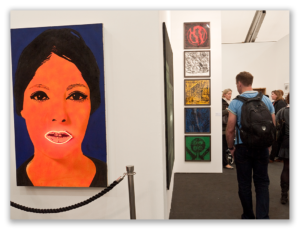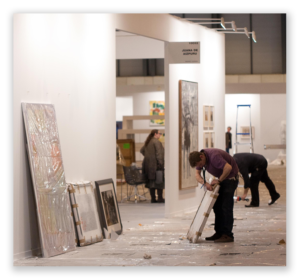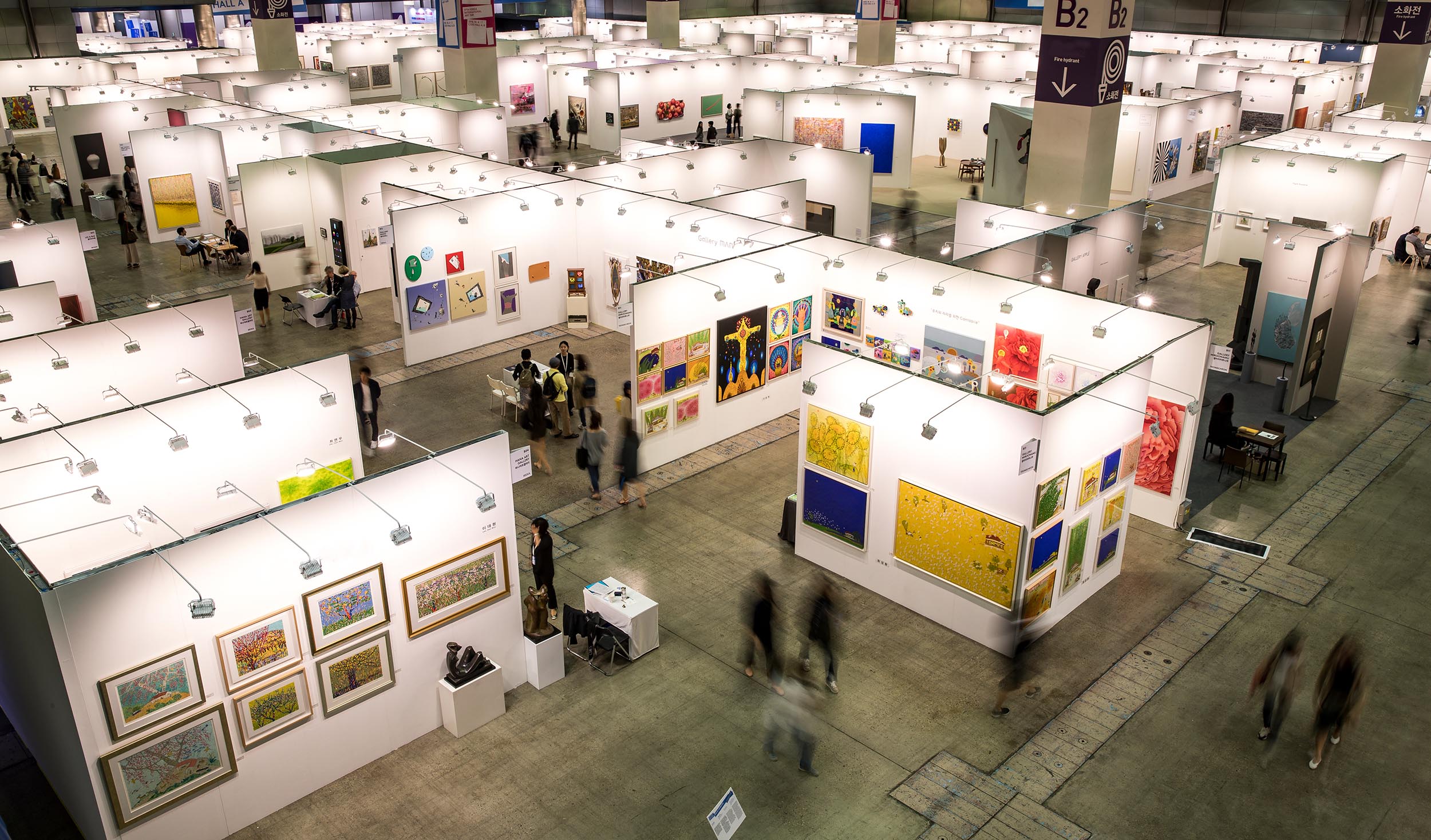 04/18/2024
04/18/2024
by Ashley Garner
Studio Assistant, Tribeca Printworks
What is an art fair? An art fair is a booth-style convention show that hosts various galleries, collectives, curators, and independent artists so they can show their art to local and international collectors for purchase. They typically last four to six days and are held worldwide in major cities.
Art fairs are application based and run by different companies with a team of curators who determine whether the application is a good fit for their specific fair. If you are participating in an upcoming art fair, read more about our fine art print and custom framing options.
Whether you’re new to the art fair world or have already participated in many fairs, you should read our nine art fair tips. You may learn something new!
Different Kinds of Art Fairs
There are a wide variety of art fairs that cater to all different styles of artists. There are fairs for:
- Illustrations
- Paper-based art
- Performance art
- Digital art
- Comic art
- Photography
- Installations
- Sculptures
- “Outsider” art
- Secondary market
- Primary market
There are also art fairs dedicated to professionals or independent and self-represented artists.
Should I Participate in an Art Fair?
Doing an art fair is a long-term investment in your career. If you’re an independent artist ready to take that next step, participating in an art fair can be a great opportunity to showcase your work to a wide new audience.
When participating as an independent artist in fairs for top-tier and emerging galleries, you’ll quickly learn that there’s no one rule for what will and will not work.
Every artist and show is different. Some artists sell out, while the booth next door doesn’t make a single sale. Some artists will walk away with offers for solo shows and corporate collections, while others will have engaged few new followers or feel like it was a waste of time.
These fairs give you the chance to connect with people you may never meet otherwise, like art advisors, gallerists, curators, and the press. Plus, you get to spend a few days with other like–minded individuals who can share their own experiences, tips, and tricks.
9 Art Fair Tips to Get the Most Out of the Experience
As fun as art fairs can be, if you’re trying to sell your art, there are a few things you should be aware of to maintain professionalism.
1. Pick Prices Before You Go to the Fair
Sometimes pricing art is the worst part of being an artist. But, it’s good to be firm in your prices before you try to sell at a fair.
If you’re struggling to price your work, there are a few options. First of all, consider the kind of art you’re selling. A photograph will price differently than a painting. Also, consider your audience and what they would pay for your art.
Don’t be afraid to ask fellow artists you know. Pricing is hard for everyone; that’s why artists created these formulas to price their work.
No matter what, be consistent with your pricing and feel confident in them before the art fair.
2. Include the Cost of Participating in the Fair in Your Prices
At the end of the day, an art fair is a company renting out wall space for you to show your work and meet new people. Some fairs are more expensive than others, so do your research to find which fair is the best for your style of work.
If possible, talk with artists who have participated in the particular fair(s) you’re interested in. Another important thing to note is that independent art fairs will often take a commission of all sales made at the fair. Consider that before applying, as you’ll want to work that into your pricing structure.
 3. Display Your Art in Interesting Ways
3. Display Your Art in Interesting Ways
How you display your art is almost as important as the art itself. You want to make sure you balance interesting visuals without overwhelming potential customers. Remember, you aren’t the only artist trying to grab people’s attention.
But you might not know how to display your art at a craft or art fair. A quick and easy way to get some free advertising is to take one of your larger pieces and place it on an easel in the front corner of your area. This will attract people from a distance.
Once you get people to your booth, ensure there’s plenty of space for them to explore. You can do this by mixing walled and tabled artwork. For example, you can hang paintings on the wall while having photo prints displayed on the table.
Make sure not to overwhelm customers by covering every inch of your booth with your art, as tempting as that is.
Here are some other helpful display tips:
- Have tablecloths for tables
- Have good lighting
- Use wood crates, stands, and baskets for smaller pieces of art
- Mix having framed and unframed work
4. Have Prints Available for Sale
Creating a beautiful layout of your original photos or prints feels good when it’s complete, but you must remember that the primary goal is to sell artwork!
As a professional artist, you must prepare other pieces of your work at more affordable prices. However, not every collector who comes to an art fair is ready to invest in a $3,000 original painting from an artist they met. Sometimes they need time to think about making that large of a purchase.
The best way to get your work into as many hands as possible is by having prints of your most popular work(s) available at lower, accessible prices. Prints can either be open or limited edition, which can affect the price of the print. Both open and limited editions are widely accepted in the art market, especially for emerging artists.
Quick tip: When having prints and photos available, protect them with plastic coverings or bags. Fingerprints and skin oil could potentially mess up your work.
5. Don’t be Afraid to Promote Yourself
Be ready to network. An art fair is an opportunity for you to talk to people face-to-face about your art so you be ready to TALK.
Have a short bio and description of your work prepared to tell people as they’re wandering the aisles of these fairs. Frequently, guests coming to these fairs go to many other shows that day—art fairs tend to occur on consecutive weekends to attract large audiences. You want to express who you are and what your art is about in a quick sentence or two.
Anything longer can get lost in translation.
If engaging potential collectors isn’t in your wheelhouse, hiring an assistant or asking a friend familiar with your work is a great way to get around this hurdle!
6. Have Business Cards Available
As mentioned before, not everyone is ready to buy art the moment they see it. You want to make sure potential collectors have a way to remember and contact you. They may later inquire about purchasing a piece they were eyeing.
Having a physical business card to hand to people can be more successful than just telling people your social media handle. You don’t need to hire a graphic designer or over-complicate the design. Keep it simple with your name, email, website, social media handle, and an example of your art.
Websites like Moo, Vistaprint, or even your local Staples or Kinkos are a great way to get business cards quickly and easily.
7. Ask for Potential Collector Contact Info
There is a statistic that for every 100 business cards passed out, only 1 will be used. It’s important to get contact information from anyone interested in your work. That way, YOU can be the one following up.
Having a notebook or mobile device to take down names and emails is extremely encouraged. For example, let’s say you were interested in a certain print but weren’t ready to buy it then and there. Then, five minutes after leaving their booth, they send you an email with a link to buy the piece so you can buy the print when you’re ready!
Following up in a timely fashion is crucial to making a sale and will absolutely make a difference in your professional impact.
8. Stand Out From the Crowd
Art fairs can be overwhelming for artists and visitors alike; even so, you still need to try to stand out from the other artists. As mentioned before, display plays a huge role.
Try putting a large piece outside your booth to grab people’s attention. Your job is to engage them, whatever it takes!
There are several things you can do to stand out. First and foremost, be friendly and approachable. You want to make people feel welcome, even if that can seem overwhelming. They are there because they are genuinely interested in your work, and this is your opportunity to shine!
If you can, do a live demonstration of your art. They’ll be curious about what you’re doing. It’s a great opportunity to talk to them about your process.
Another idea is to play some soft music. Make your space a peaceful refuge from the bustling art fair. People will want to see where the music is coming from and stay to catch their breath.
Finally, don’t skimp when it comes to the presentation of your art. Have your pieces professionally printed and framed. Consider displaying your art in a variety of printing and framing treatments so potential customers can envision the possibilities. We are always happy to consult with you to find the best options for your work!
9. Have Fun
Doing an art show on any level can be stressful, but it’s important to remember to have fun! This is a chance for you to expand your network and introduce people to your work that may have never found it otherwise. The happier you look in your booth, the more likely people will want to approach you and learn more.
If you expect to make thousands of dollars over the course of the show, you may be disappointed. Many sales occur after the fair itself, which is why having a great website to showcase your work is also very important. But, if you join an art fair hoping to meet people who want to learn more about who you are, you’re likely to have a great time.
Making sales is just an added bonus!
Popular Art Shows to Try!
Here are a few art fairs to look into as an independent artist that happen in cities like New York, LA, London, Chicago, Miami, Jersey City, and Dallas:
- The Other Art Fair
- Spring/Break
- Moniker Art Fair
- Art Fair 14C
- 1-54 African Art Fair
- Affordable Art Fair
- Satellite Art Show
- Art on Paper
- Spectrum
- Red Dot
- Superfine! Art Fair
Feel Confident at Every Art Fair
We hope our art fair guide helped you feel a bit more confident about participating in one. If you’ve decided to join an art fair, Tribeca Printworks is here to help! We have all the printing and framing solutions for a successful booth and art fair experience.
You can drop by our SOHO Studio anytime to view samples or schedule a consultation to determine the best direction for your photos, paintings, and other pieces of artwork.
Check out how our other clients have displayed their work at art fairs for inspiration!
What Is The best Way To Print My Art and Photography?
How should I print my photos and artwork? You’ve come to the point in your artistic career where you’re ready to take it to the next level and start printing your work. Perhaps it is exporting those photos off your camera for the first time…READ MORE
by Ashley Garner 04/17/2020
How Should I Frame My Photos and Artwork?
What is the best way to frame my photos and artwork? Framing your art and photography can transform a space and transform your work. The process can seem daunting and the possibilities endless, but we’re here to help simplify and shed some light…READ MORE

